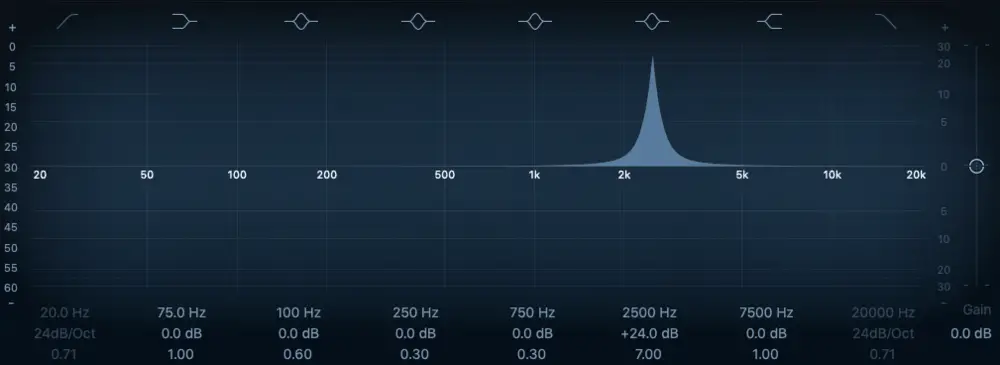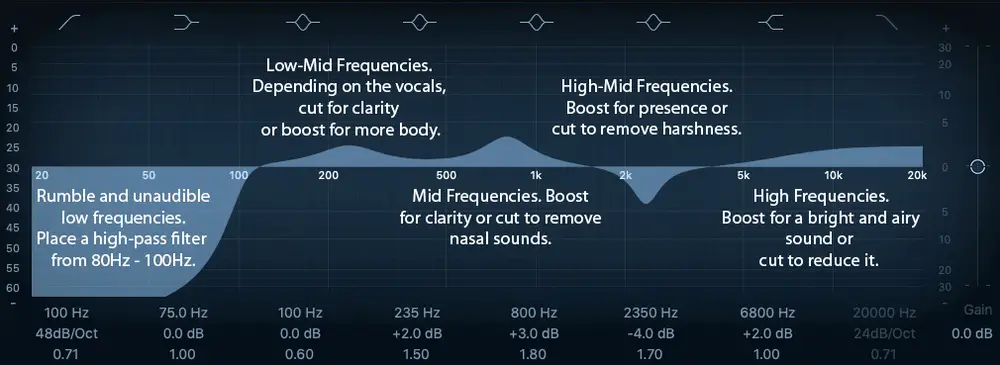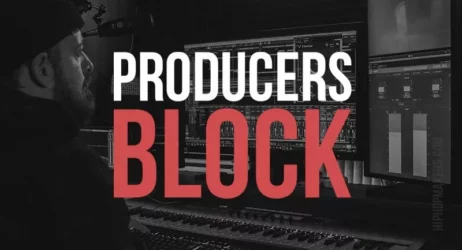Mixing vocals can be challenging for beginners and music producers who want their music to sound professional. So here are tips for mixing vocals to sound their best.

How to Mix Vocals
1. Get it Sounding Good from the Start

If you ask any top tier mixing engineers what’s the first step on mixing vocals, they will always say “get it sounding good from the start”.
That means while recording vocals you should think ahead on how well it will sit in the mix, potential issues, etc. Things like a great-sounding room and proper positioning from the singer can make a huge difference.
Take some time to find the best microphone for the singer’s voice. These simple steps will make mixing much easier.
2. Cutting Out Unwanted Frequencies

A consensus in mixing is that you should cut before boosting.
Find unwanted frequencies using a sweep EQ. Depicted above.
Set your Q value to around 7 and the frequency gain to the largest value possible (usually +24dB), then sweep around the frequency spectrum and look for harsh frequencies.
This tip will make your vocals sound much clearer when mixing vocals.
3. Know the Frequency Spectrum

The human voice is incredibly complicated to categorize.
Each voice has a very unique timbre that will depend on a variety of factors.
You will probably never find two people with the same voice. That’s why you need to train your ears and know the frequency spectrum very well to identify those subtle differences.
We can’t put every voice in the same box, the image above shows you some guidelines to get you started.
4. Compress Audio the Right Way

Compression is perhaps the most misunderstood effect in music. Take some time to learn how it works and your mix will sound much better.
On vocals, it’s important to not over-compress, with the risk of making it sound unnatural and robotic.
You want the compressor to slightly even out the performance and reduce peaks.
On most compressors you will find four main knobs:
- Threshold
- Ratio
- Attack
- Release
Basically, threshold means how loud the sound has to be before the compression starts, ratio deals with how much compression is applied (for instance, 4:1 = for every 4dB over the threshold, the signal is increased by 1dB; Attack, meaning how fast the compressor is going to kick in and release, stating how long until the compressor stops.
There are no hard and fast rules for using compressors. We recommend starting with a slow attack, fast release, a threshold of about -20dB and a ratio of 4:1.
From there roll back the knobs until you find a sweet spot.
Tutorial: Audio Basics: How to Use a Compressor
5. Parallel Compression
A commonly used technique to make the vocals pop out in the mix is to send it in to a bus or duplicate the track, and applying heavy compression to the duplicated one.
From there, adjust the levels between the parallel compressed track and the original one; Always remember to be subtle when doing this, a little goes a long way.
We recommend starting with the following compression settings:
- -40 dB threshold
- 8:1 ratio
- 0ms attack
- 100ms release
It’s also cool to test different types of compressors for the job, especially analog-based ones.
6. Volume & Effect Automation

Vocal performances can often sound unbalanced and with some parts louder than others, that’s why it’s a great practice to do some volume automation to get a more even sounding recording.
You can also automate effects such as reverbs and delays according to what each part of the song asks for.
Video: Use Volume Automation To Bring Your Mixes To Life
7. Use Reverb and Delay Correctly
Ambient effects can both ruin your mix or make it shine.
A foolproof way to tell a bad mix from a good one is to listen to how the ambiance is used
A bad mix is often drenched in unnecessary reverb.
In most cases, the vocals are the main element of the song and need to be very close to the listener.
A rule of thumb is to remember the more reverb you apply to the vocal track, the more it will be pushed back in the mix, so be careful with it.
You can use stereo or slapback delays to make your vocals sound wider without pushing them to the back of the arrangement.
This is a technique used and often recommended by many top-notch mixing engineers.
Related: 50 Best Free Reverb VST Plugins
Conclusion
Get your vocals sounding good from the start and make your life easier by paying attention to things such as vocalist positioning, room sounds, and more.
Start working on the vocals by cutting unwanted frequencies using a sweep EQ.
Each voice is unique. Train your ears to identify the characteristics and nuances of each one of them.
Make sure you don’t over-compress your vocals, try to make it sound even while as natural as possible.
If you’re having difficulties making the vocals cut in the mix, try using subtle parallel compression.
Automate the volume and certain effects of your vocal tracks to make it sound balanced.
Use reverb and delays correctly and according to the other elements of the song.
Do you have any tips on mixing vocals?
Please share it below.





